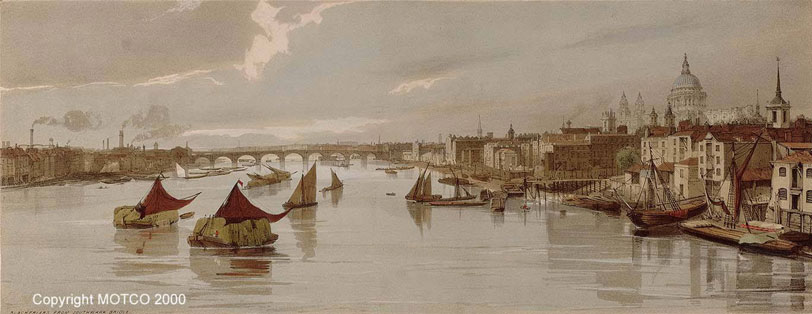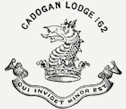Prepared and spoken by the Grand Chaplain Canon Richard Tydeman
Celebrated on 11th April 1967

MID-19th CENTURY LONDON - WITH BLACKFRIARS BRIDGE VISIBLE IN THE BACKGROUND
"His Majesty King George III came to the throne of this land in the year 1760 and the first ten years of his reign are now chiefly remembered for their disasters.
For this was a period of anticlimax. The end of the previous reign had seen the foundation of the Indian Empire, General Wolfe's victory at Quebec, the French fleet almost annihilated at Quiberon Bay and their land forces defeated at the battle of Minden.
Now all that was over, in the seventeen-sixties, France, uniting with Spain, was trying to keep Britain out of Europe; then came the collapse of Pitt's government, the withdrawal of British troops from Germany and, worst of all, the threat of an Unilateral Declaration of Independence by our American Colonies, answered by sanctions and restrictions which led to rioting, bloodshed and battle.
Division, dissention, disappointment were the key-notes of the age.
And in the midst of all this, down on the River Thames near the old Monastery of the Black Friars, a little band of Operative Masons began to build a bridge. Observe, Brethren, the significance of this.
In the Middle Ages there had been an Order of "Travelling Freemasons" known as "The Bridge-Builders", who moved about Europe building bridges, just as other Brethren were building Churches and Cathedrals. Legend attributes the foundation of the Order to Saint Benezet who built the wonderful bridge at Avignon nearly eight hundred years ago. By the end of the sixteenth century the Order had died out and much of its property passed to the Knights of Malta; but there has always remained a strong connection between Freemasonry and Bridge-building in more ways than one, as we shall see.
A bridge is one of the noblest structures ever devised, being formed of that greatest architectural achievement, the arch; its characteristics are Wisdom, Strength and Beauty.
First, a bridge is undoubtedly a thing of beauty and symmetry, pleasing to the eye and attractive to the artist who is ever ready to paint pictures of it, whether it be a suspension over a mighty harbour or a rustic plank across a stream.
Next, a bridge must, by its nature, be an example of strength. The difficulties of building such a bridge as Blackfriars were enormous: in deep, swift-flowing. tidal water, it was necessary to sink the foundations of eight great piers to support the semi- elliptical arches. They could not float on the water: they could not rest on the shifting mud and sand below; they had to go right down into the solid riverbed underneath. Such were the strong and secure foundations of the old Blackfriars Bridge.
Beauty, then, and strength are here exhibited. But more than that: here is a supreme example of Wisdom.
For perhaps the most important and striking characteristic of a bridge is that it is built for the purpose of joining two sides of a river together. Almost every other kind of structure is built for the purpose of dividing: every wall is erected to divide the people or property on one side of it from the people or property on the other; every house divides the space within from the world without; even a Temple may tend to divide the affairs of God from the affairs of man, perhaps with a 'middle wall of partition' to cause a barrier.
But a bridge does none of these things. It is built for the sole and splendid purpose of joining - promoting communication between two sides which were previously unconnected. Could there be a more useful or a more worthy project?
And notice, further, that it does this without any inconvenience whatever to the river itself. Beneath the bridge, the tide continues regularly to ebb and flow twice in twenty-four hours; while ships on their lawful occasions, whether pleasure boats or barges of merchandise, carry on the life and commerce of the river unimpeded by the traffic passing over the bridge above.
What artistry, what intelligence, what wisdom is here displayed? No wonder that the ancient Romans used to give to their chief High Priest the imposing title 'Pontifex Maximum' which literally means 'Greatest of Bridge-builders'; it reminds us that the principal duty of every priest, minister or chaplain is to form a bridge between God and man and to establish communication between man and his neighbour.
But the Wisdom, Strength and Beauty found in a bridge are also the three great qualities found in Freemasonry, which is itself a species of bridge, joining together just. upright and free men of many different races, languages and creeds. To the uninstructed and popular world we may appear to be building walls of division but this is not really the case. Masonry has no desire to interfere in the affairs of the world: rather it rises above them, forming strong lines of communication between men of goodwill, while the world ebbs and flows unimpeded.
From that little hand of Operative Masons at Blackfriars, there sprang in 1767 the Black Fryers Bridge Lodge, which immediately began establishing lines of communication all over this country and beyond. For early records show that it attracted Candidates from as far apart as Ipswich. Aberystwyth and New York. Strategically placed at the Kings Arms in Southwark, the Lodge was soon able to span more than just the River Thames; it was also spanning the Orwell, the Severn and even the Atlantic. And so it has continued.
The old Blackfriars Bridge itself was entirely reconstructed less than a hundred years later; at about the same time the Lodge changed its name to Cadogan — a name equally redolent of Wisdom, Strength and Beauty, for the holders of this name have ever been renowned for their ability to bring peace out of strife and to form bridges of communication in a divided world.
Today we reach a landmark in the history of the Lodge, the achievement of a Bi-Centenary. It is proper that we should celebrate such landmarks with due pomp and rejoicing. But Brethren, let us never forget that old age alone has little to commend it. Long life is of no distinction unless accompanied by honour. Freemasonry is both ancient and honourable, the honour of the past reflecting itself in the character of its present members.
So let this Bi-Centenary be not merely the celebration of two hundred years of existence but of two hundred years of faithful and effective bridge-building. There has never been a time when communication between men of good will was so vitally important as it is at present. Most of the difficulties in this divided world are caused by misunderstanding and most misunderstanding could be overcome, if only there were more bridges linking the hearts and minds of men together.
May this distinguished and honourable Lodge long continue to promote communication, to join together all that is best in mankind and to exhibit the Wisdom. Strength and Beauty of the Great Bridge-Builder of the Universe, throughout all the centuries that lie ahead."
Return to Cadogan Lodge History - Part 1 - The Original Charter
